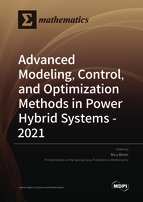Advanced Modeling, Control, and Optimization Methods in Power Hybrid Systems - 2021
A special issue of Mathematics (ISSN 2227-7390). This special issue belongs to the section "Engineering Mathematics".
Deadline for manuscript submissions: closed (1 March 2022) | Viewed by 35604
Special Issue Editor
Interests: electrical engineering; power electronics; power converters; inverters; renewable energy; energy efficiency; energy storage; fuel cell; hybrid power systems; control; optimization; MATLAB simulation
Special Issues, Collections and Topics in MDPI journals
Special Issue Information
Dear Colleagues,
The generation of distributed electricity using micro- and nano-grids is an obvious opportunity to reduce CO2 emissions if hydrogen energy technology is used in addition to renewable energy potential. It is expected that these hybrid microgrids will play an important role in the implementation of the scenario of limiting global warming to 20 C by replacing fossil fuels with renewables.
Thus, to highlight the latest solutions and paradigms in hybrid microgrids, such as vehicle-to-everything (V2X), power-following control, grid-responsive strategies, and global optimization strategies, this Special Issue, titled “Advanced Modeling and Research in Hybrid Microgrid Control and Optimization”, is proposed for Mathematics from MDPI, which is an international peer-reviewed open access covered by many databased such WOS (SCIE Impact Factor 1.747 (2019), Q1) and SCOPUS (Elsevier). The present Special Issue aims to collect innovative solutions and experimental research supported by appropriate modeling and design, as well as state-of-the-art studies, in the following topics:
- Hybrid nano- and micro-grids;
- Hybrid power systems (HPSs);
- Renewable energy sources (RESs);
- Fuel Cell (FC) systems;
- Hybrid energy storage systems (HESSs);
- Smart contracts based on IoT blockchain technology;
- Cyber-security, reliability, maintenance, resilience, and safety in the operation of FC/RES hybrid microgrids;
- Energy management and optimization strategies for FC/RES HPS;
- Control, optimization, and energy management strategies for hybrid/FC/electrical vehicles;
- Vehicle-to-everything (V2X) architectures;
- Communication architectures for microgrids.
Prof. Dr. Nicu Bizon
Guest Editor
Manuscript Submission Information
Manuscripts should be submitted online at www.mdpi.com by registering and logging in to this website. Once you are registered, click here to go to the submission form. Manuscripts can be submitted until the deadline. All submissions that pass pre-check are peer-reviewed. Accepted papers will be published continuously in the journal (as soon as accepted) and will be listed together on the special issue website. Research articles, review articles as well as short communications are invited. For planned papers, a title and short abstract (about 100 words) can be sent to the Editorial Office for announcement on this website.
Submitted manuscripts should not have been published previously, nor be under consideration for publication elsewhere (except conference proceedings papers). All manuscripts are thoroughly refereed through a single-blind peer-review process. A guide for authors and other relevant information for submission of manuscripts is available on the Instructions for Authors page. Mathematics is an international peer-reviewed open access semimonthly journal published by MDPI.
Please visit the Instructions for Authors page before submitting a manuscript. The Article Processing Charge (APC) for publication in this open access journal is 2600 CHF (Swiss Francs). Submitted papers should be well formatted and use good English. Authors may use MDPI's English editing service prior to publication or during author revisions.
Keywords
- Hybrid nano- and micro-grids
- Hybrid power systems (HPSs)
- Renewable energy sources (RESs)
- Fuel cell (FC) systems
- FC RES hybrid microgrids
- Energy management strategies (EMSs)
- Blockchain technology
- Smart contracts
- Hybrid energy storage systems (HESSs)
- Fuel cell vehicles (FCVs)
- Vehicle-to-everything (V2X)
- Vehicle-to-building (V2B)
- Vehicle-to-grid (V2G)
- Optimization strategies
- Energy management strategies
- System modeling and design
- Cyber-security
- Communication
- Reliability, maintenance, resilience, and safety in operation.






